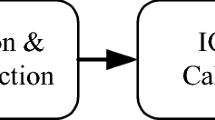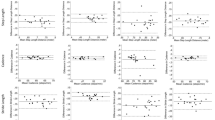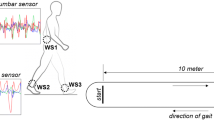Abstract
A disturbance in gait pattern is a serious problem in patients with rheumatoid arthritis (RA). The aim of the present study was to examine the utility of the smartphone gait analysis application in patients with RA. The smartphone gait analysis application was used to assess 39 patients with RA (age 65.9 ± 10.0 years, disease duration 11.9 ± 9.4 years) and age-matched control individuals (mean age, 69.1 ± 5.8 years). For all RA patients, the following data were obtained: disease activity score (DAS) 28, modified health assessment questionnaire (mHAQ), and assessment of walking ability. Patients walked 20 m at their preferred speed, and trunk acceleration was measured using a Smartphone. After signal processing, we calculated the following gait parameters for each measurement terminal: peak frequency (PF), autocorrelation peak (AC), and coefficient of variance (CV) of the acceleration peak intervals. The gait parameters of RA and control groups were compared to examine the comparability of the 2 groups. Criterion-related validity was determined by evaluating the correlation between gait parameters and clinical parameters using Spearman’s correlation coefficient. The RA group showed significantly lower scores for the walking speed, AC, and CV than the control group. There were no significant differences in PF. PF (gait cycle) was mildly associated with gait speed (P < 0.05). AC (gait balance) was moderately associated with the DAS, mHAQ, gait ability, and gait speed (P < 0.05). CV (gait variability) was moderately associated with the DAS, gait ability, and gait speed (P < 0.05). This is the first study to examine the use of a smartphone device for gait pattern measurement. The results suggest that some gait parameters recorded using the smartphone represent an acceptable assessment tool for gait in patients with RA.


Similar content being viewed by others
References
Silman AJ (1994) Epidemiology of rheumatoid arthritis. APMIS 102(10):721–728
Murphy D (1996) Lycra working splint for the rheumatoid arthritic hand with MCP ulnar deviation. Aust J Rural Health 4(4):217–220
Farr JN, Going SB, Lohman TG, Rankin L et al (2008) Physical activity levels in patients with early knee osteoarthritis measured by accelerometry. Arthritis Rheum 59(9):1229–1236
Myllykangas-Luosujärvi RA, Aho K, Isomäki HA (1995) Mortality in rheumatoid arthritis. Semin Arthritis Rheum 25(3):193–202
Luqmani R, Hennell S, Estrach C et al (2006) British Society for Rheumatology and British Health Professionals in Rheumatology guideline for the management of rheumatoid arthritis (the first two years). Rheumatology 45:1167–1169
Sakauchi M, Narushima K, Sone H et al (2001) Kinematic approach to gait analysis in patients with rheumatoid arthritis involving the knee joint. Arthritis Rheum 45(1):35–41
Laroche D, Pozzo T, Ornetti P et al (2006) Effects of loss of metatarsophalangeal joint mobility on gait in rheumatoid arthritis patients. Rheumatology 45(4):435–440
O’Connell PG, Lohmann Siegel K, Kepple TM (1998) Forefoot deformity, pain, and mobility in rheumatoid and nonarthritic subjects. J Rheumatol 25(9):1681–1686
Bautmans I, Jansen B, Van Keymolen B et al (2011) Reliability and clinical correlates of 3D-accelerometry based gait analysis outcomes according to age and fall-risk. Gait Posture 33(3):366–372
Mizuike C, Ohgi S, Morita S (2009) Analysis of stroke patient walking dynamics using a tri-axial accelerometer. Gait Posture 30(1):60–64
Lowry KA, Smiley-Oyen AL, Carrel AJ et al (2009) Walking stability using harmonic ratios in Parkinson’s disease. Mov Disord 24(2):261–267
LeMoyne R, Mastroianni T, Cozza M et al (2010) Implementation of an iPhone as a wireless accelerometer for quantifying gait characteristics. In: Conference of the proceedings of IEEE Eng Med Biol Soc, pp 3847–3851
Prevoo ML, van’t Hof MA, Kuper HH et al (1995) Modified disease activity scores that include twenty-eight-joint counts. Development and validation in a prospective longitudinal study of patients with rheumatoid arthritis. Arthritis Rheum 38(1):44–48
Bruce B, Fries JF (2003) The Stanford Health Assessment Questionnaire: a review of its history, issues, progress, and documentation. J Rheumatol 30(1):167–178
Niki H, Aoki H, Inokuchi S (2005) Development and reliability of a standard rating system for outcome measurement of foot and ankle disorders I: development of standard rating system. J Orthop Sci 10(5):457–465
Auvinet B, Berrut G, Touzard C (2002) Reference data for normal subjects obtained with anaccelerometric device. Gait Pos 16:124–134
Moe-Nilssen R, Helbostad JL (2004) Estimation of gait cycle characteristics by trunk accelerometry. J Biomech 37:121–126
Hausdorff JM, Rios DA, Edelberg HK (2001) Gait variability and fall risk in community-living older adults: a 1-year prospective study. Arch Phys Med Rehabil 82:1050–1056
Beauchet O, Allali G, Annweiler C et al (2009) Gait variability among healthy adults: low and high stride-to-stride variability are both a reflection of gait stability. J Gerontol 55:702–706
Lelas JL, Merriman GJ, Riley PO (2003) Predicting peak kinematic and kinetic parameters from gait speed. Gait Posture 17(2):106–112
Barlow JH, Turner AP, Wright CC (2000) A randomized controlled study of the Arthritis Self-Management Programme in the UK. Health Educ Res 15(6):665–680
Foster G, Taylor SJ, Eldridge SE et al (2007) Self-management education programmes by lay leaders for people with chronic conditions. Cochrane Database Syst Rev 17(4):CD005108
Hewlett S, Ambler N, Almeida C et al (2011) Self-management of fatigue in rheumatoid arthritis: a randomised controlled trial of group cognitive-behavioural therapy. Ann Rheum Dis 70(6):1060–1067
Barlow J, Turner A, Swaby L (2009) An 8-yr follow-up of arthritis self-management programme participants. Rheumatology 48(2):128–133
Smarr KL, Musser DR, Shigaki CL et al (2011) Online self-management in rheumatoid arthritis: a patient-centered model application. Telemed J E Health 17(2):104–110
Acknowledgments
We would like to thank all the volunteers for participating in the study. We would also like to acknowledge the students of the Department of Human Health Sciences at Kyoto University for assisting in the data collection.
Author information
Authors and Affiliations
Corresponding author
Rights and permissions
About this article
Cite this article
Yamada, M., Aoyama, T., Mori, S. et al. Objective assessment of abnormal gait in patients with rheumatoid arthritis using a smartphone. Rheumatol Int 32, 3869–3874 (2012). https://doi.org/10.1007/s00296-011-2283-2
Received:
Accepted:
Published:
Issue Date:
DOI: https://doi.org/10.1007/s00296-011-2283-2




